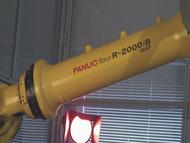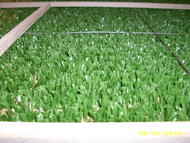The summary results clearly show a low level of wear that was observed to be caused by the brushing alone. The life of 20 years was used to represent a period of time longer than most artificial surfaces survive in practice. In reality, the effects of surface usage for playing the sport or training (total weekly hours at Loughborough University for example, is around 50-60 per week on the soccer/rugby surfaces) and environmental effects are considered to be the main contributors to wear.
Dr. Paul Fleming BEng PhD MIHT, Loughborough University
If you want to get the most out of your pitch or need your surface to pass stringent performance criteria, such as the FIFA 2* testing, Technical Surfaces can help. Call us now on 08702 400 700, or contact us for more details.
Technical Surfaces, the UK’s leading synthetic maintenance specialists, has commissioned the Sports Technology Institute at Loughborough University to undertake independent research into the effects of brushing on the wear of synthetic sports carpet systems. Their findings, detailed below, challenges many preconceptions regarding artificial turf maintenance, and have demonstrated for the first time the influence of long term maintenance on synthetic turf.
The objective of the recent Laboratory Experimental Investigation of ‘Sports Surfaces Wear’ from Mechanical Brushing, conducted by Dr. Paul Fleming at Loughborough University, was to determine the impact of routine maintenance on the wear and quality of synthetic turf. This was assessed by replicating, in laboratory conditions, the mechanical rotating brushes used on synthetic sports facilities, to measure the wear over a number of cycles of brushing on a series of carpet systems.
The conclusions drawn from this groundbreaking investigation are clear and unequivocal; the levels of wear caused by the brushes used by Technical Surfaces to maintain synthetic sports surfaces were insignificant.
“The summary results clearly show a low level of wear that was observed to be caused by the brushing alone,” commented Dr. Fleming. “The life of 20 years was used to represent a period of time longer than most artificial surfaces survive in practice. In reality, the effects of surface usage for playing the sport or training (total weekly hours at Loughborough University for example, is around 50-60 per week on the soccer/rugby surfaces) and environmental effects are considered to be the main contributors to wear.”
Loughborough University is widely recognised as the world’s leading sports technology research facility and is the UK’s premier sports university. The facility is dedicated to the pursuit of excellence within sport, and their independent findings add considerable weight and validity to Technical Surfaces’ own philosophy on the importance of regular maintenance to synthetic sports surfaces. Indeed, the findings of Dr. Fleming confirm that regular brushing, carried out in the correct frequency and with the right machinery, will not detrimentally damage the carpet.
“We began sweeping our first synthetic pitch back in 1995,” says Jonathan Gunn, Technical Director at Technical Surfaces. “This evidence will be used to silence the critics within the industry who hold the misconception that synthetic surfaces are maintenance free, rather than the pitch or facility owners who have always been more than happy with the work we have carried out.”
The preliminary meetings between Technical Surfaces and Dr. Fleming identified three brush types and three surface types for testing. The specifications for the test procedure (including rotation speed, brush head and ground speed, depth of brush embedment into the surface under test, direction of rotation and brush size) were also agreed during the initial trials. This ensured that the testing was representative of what occurs on site.
“The tests basically concentrated on three brushing techniques that we use – frequent/regular soft brushing, frequent/regular hard brushing and more intensive annual or bi-annual Revite®. The reason we use two different types of brush on our frequent monthly/bi-monthly sweeping is dependent on surface type, to ensure that each facility is provided with the optimal maintenance for their own specific needs,” says Jonathan.
In order to evaluate a number of different conditions, several combinations of brushing cycles were chosen, some of which were extreme, to investigate alternative maintenance regimes and provide more definitive results. The cycles chosen give extreme examples of the use of Technical Surfaces’ brushing techniques, as we wanted to show the worst-case scenario and give a definitive conclusion. Therefore, the cycles for the Regular brush replicated a weekly frequency (which is certainly possible); although in reality this type of brushing is generally carried out at best on a monthly basis to complement in-house drag brushing. Therefore, the results for this section can, in theory, be multiplied by four to produce even more staggering results of up to 80 years of brushing, still with minimal damage.
When you consider that most facilities only expect their pitch to last for a 10 year cycle, these figures show how the work that Technical Surfaces does has no impact on the shortening of a pitch’s life. Indeed, the oldest pitch that we maintain is now nearly 25 years old.
It is thus considered that this study has shown the contribution of maintenance brushing related wear to be insignificant in comparison to the wear expected from surface use and exposure to the environment.
Technical Surfaces conducts maintenance on hundreds of facilities throughout the UK, many of which are operating well beyond their original expected life. This research demonstrates independently that this maintenance has no detrimental effect on the surfaces’ quality or lifespan. What are evident are the ongoing long-term benefits of maintenance from Technical Surfaces and the subsequent increase in performance and life expectancy that many of our customers experience day in day out.
Technical Surfaces has a wealth of field experience and data to support that what we do is extremely effective at prolonging the life of any synthetic surface. With on-going testing and analysis of facilities’ sites, you can rest assured that your surface will always be in the best possible hands.


